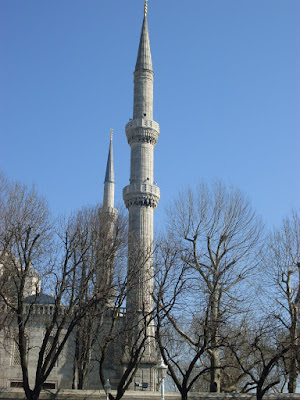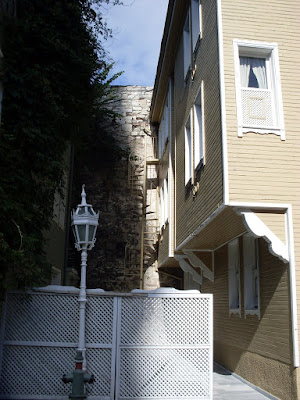I visited
Sultan Ahmed Masjid for the second time a little while ago; it's one of my favourites. People frequently advise me that women's prayers are better at home, and it is difficult for me to pray in public, so I should just stay home. I agree with them, but I love praying in masjids, and I would go nuts if I stayed home all the time.
Built by
Sultan Ahmed I, who became sultan at the age of 13, and began work on the masjid in 1609 at the age of 19. He was a devout Muslim who decided not to participate in the Ottoman tradition of fratricide to secure his throne, and sent his brother Mustafa to live with their grandmother after becoming sultan. The masjid was officially opened in 1617, but was not quite completed when Ahmed I died the same year of typhus, at the age of 27. He was interred in a mausoleum outside the masjid, and his brother and successor Mustafa I signed the final accounts for the completion of the masjid.
(An image of the masjid taken prior to 1895).

I took this photo from the upper story of a museum of Islamic art across the square from the masjid. It's so big that it's hard to photograph the whole thing except from a distance. The masjid has the capacity to hold 10,000 worshippers, it is BIG.

This one was taken from across the square, outside the Hagia Sophia.

The gardens are lovely; I took these photos on my last visit, in the spring. I have spent enough time in Istanbul that I don't photograph absolutely everything anymore.



Here are two of the entrances. There is a very heavy green flap over the door, you lift a corner of it to enter.


Two of the huge old doors.


Some views of the courtyard. The little gazebo-like building in the middle is the men's wudu station; they are usually much larger and more ornate at the big Ottoman masjids.



Some of the beautifully painted ceilings in the courtyard.



And, finally, the interior of the masjid, lined with 20,000 blue tiles handmade at Iznik, patterned with flowers, fruit, and cypress trees. Sultan Ahmed I decreed a fixed price to be paid for the tiles, but the price of tiles necessarily increased over time, so their quality decreased over the eight years it took to build the masjid.

The interior is dimly lit by 260 stained glass windows. The original glass is gone, but they are still very beautiful. The original lamps are gone as well, mostly to museums.



Notable for its six minarets (most masjids have one, two, or four), I have heard tour guides telling an apocryphal story that people were scandalized when Sultan Ahmed built the masjid, because the only masjid at the time to have six minarets was the Masjid Al-Haraam in Mecca. Supposedly, the sultan sent a crew to the Masjid Al-Haraam to build a seventh minaret and solve the problem. However, the seventh minaret on the Masjid Al-Haraam was added more than a century before the Masjid Sultan Ahmet was even thought of.
As we were leaving the masjid after prayers, a little old lady walk toward me, filming me with a digital video camera. Her friend, who barely came up to my shoulder, hugged me and spoke to me in what turned out to be Chechnyan, filming the whole time. I think she thought I was Arab. This happens a lot at tourist sites, and I don’t mind. I appreciate if they ask before photographing me, but most people don’t.
On the way out of the masjid:



 An Ottoman water tap.
An Ottoman water tap. There are an art gallery and some fancy cafes, towards the end of the street.
There are an art gallery and some fancy cafes, towards the end of the street. Men carrying large trays of things through crowds are a common sight in Istanbul, but it was not crowded today.
Men carrying large trays of things through crowds are a common sight in Istanbul, but it was not crowded today. Looking back up the street from the end:
Looking back up the street from the end:
 Street art outside an art gallery:
Street art outside an art gallery:

 An Ottoman water tap.
An Ottoman water tap. There are an art gallery and some fancy cafes, towards the end of the street.
There are an art gallery and some fancy cafes, towards the end of the street. Men carrying large trays of things through crowds are a common sight in Istanbul, but it was not crowded today.
Men carrying large trays of things through crowds are a common sight in Istanbul, but it was not crowded today. Looking back up the street from the end:
Looking back up the street from the end:
 Street art outside an art gallery:
Street art outside an art gallery:





.JPG)



.JPG)

.JPG)
.JPG)



.JPG)





















